The tougher cuts of beef usually used for pot roast — such as rump roast, top round, bottom round, eye of round, sirloin tip, etc. — can up beautifully.
When opening the jar, don’t waste the broth that is in the jar, it’s pure gold: freeze it for use in soups, stews, risottos, gravies, etc.
For the sake of convenience, we’ll refer to “beef round”, though all the above cuts are meant.
Quantities of beef round needed
On average, as a very rough guideline, expect to need about 500 g (1 lb) of beef round per half-litre (US pint) jar of canned beef round.
The recipe
Jar size choices: Either half-litre (1 US pint) OR 1 litre (1 US quart)
Processing method: Pressure canning only
Yield: varies
Headspace: 3 cm (1 inch)
Processing pressure: 10 lbs (69 kPa) weighted gauge, 11 lbs (76 kpa) dial gauge (adjust pressure for your altitude when over 300 metres / 1000 feet)
Processing time: Half-litres (pints) 75 minutes; litres (quarts) 90 minutes
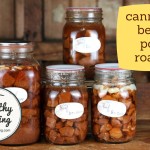
Pressure canning beef round
Ingredients
- beef round
- water
- pickling salt (optional)
Instructions
- Trim off any gristle.
- Cut meat into cubes or strips.
- Spray a skillet with cooking spray or heat a small amount of fat or oil in it.
- Brown outsides of the pieces of meat in the skillet in batches; transfer browned meat to a covered bowl or pot to keep hot.
- Pack meat into half-litre (1 US pint) OR 1 litre (1 US quart) jars.
- Leave 3 cm (1 inch) headspace.
- [Optional]: add ½ teaspoon pickling salt to half-litre (1 US pint) jars; 1 teaspoon of pickling salt to 1 litre (1 US quart) jars.
- Top jars up with a boiling liquid (water from a kettle, meat, stock, or tomato juice) maintaining 3 cm (1 inch) headspace.
- Debubble; adjust headspace.
- Wipe jar rims.
- Put lids on.
- Processing pressure: 10 lbs (69 kPa) weighted gauge, 11 lbs (76 kpa) dial gauge (adjust pressure for your altitude when over 300 metres / 1000 feet)
- Processing time: half-litre (US pint) jars for 75 minutes OR 1 litre (US quart) jars for 90 minutes.
Nutrition
Processing guidelines below are for weighted-gauge pressure canners. See also if applicable: Dial-gauge pressures.
| Jar Size | Time | 0 to 300 m (0 - 1000 feet) pressure | Above 300 m (1000 ft) pressure | |
|---|---|---|---|---|
| ½ litre (1 US pint) | 75 mins | 10 lbs | 15 lb | |
| 1 litre (1 US quart) | 90 mins | 10 lbs | 15 lb |
Reference information
How to pressure can.
When pressure canning, you must adjust the pressure for your altitude.
More information on canning meat.
Storage life of home canned goods
Recipe notes
- Instead of the salt, you can use a non-bitter, non-clouding salt sub. We have found Herbamare Sodium-Free performs well in that regard.
- Ball / Bernardin Complete Book (2015, page 396) suggests that if you have a lot of meat to brown, spread it out in roasting pans / trays and sear in a hot oven until brown on the outside but still rare on the inside.
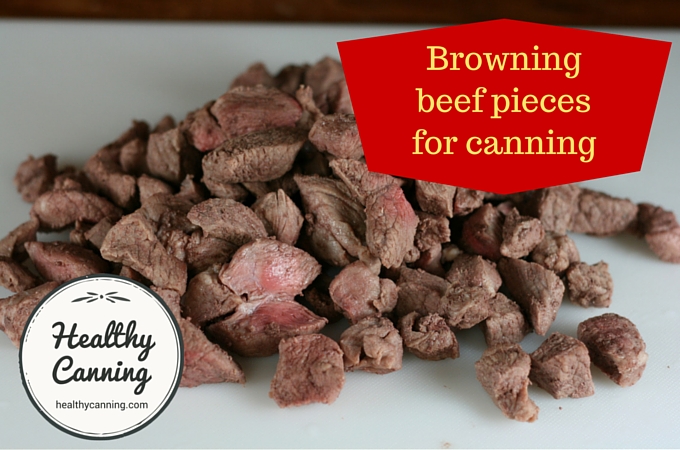
These pieces of beef are sufficiently browned for canning. You just need the outsides browned so they won’t stick together in the jar: it’s a waste of cooking fuel to brown them anymore, because they will fully cook in the canning process, anyway.
Recipe source
This recipe comes from the USDA Complete Guide (2015.)
- Strips, Cubes or Chunks of Meat. In: United States Department of Agriculture (USDA). Complete guide to home canning. Agriculture information bulletin No. 539. 2015. Page 5- 6.
Note, the USDA also gives a raw-pack option.
Nutrition
Nutritional information based on lean beef round.
Serving size: 100 g (3.5 oz / ⅕th of a ½ litre / US pint jar)
Per 100 g:
- 94 calories, 59 mg sodium.
- Weight Watchers PointsPlus®: 100 g (3.5 oz) = 2 points
* Nutrition info provided by https://caloriecount.about.com
* PointsPlus™ calculated by healthycanning.com. Not endorsed by Weight Watchers® International, Inc, which is the owner of the PointsPlus® registered trademark.
The canning broth
The USDA Complete Guide (2015) advises to fill with a boiling liquid (water from a kettle, meat, stock, or tomato juice). In their advice the liquid is meant to be unthickened.
The Ball / Bernardin Complete Book (2015) allows the canning broth for cubes or strips of meat to be slightly thickened with Clearjel. “If desired, ClearJel can be used to lightly thicken the broth in this recipe.” [1]Kingry, Judi and Lauren Devine. Ball / Bernardin Complete Book of Home Preserving. Toronto: Robert Rose. 2015. Page 397. Ring version. They do not state what “lightly” means.
How large should the cubes of meat be?
Bernardin Guide says, ” ½ to 1 inch (2 to 3 cm) pieces” (Bernardin Guide 2103. page 100).
Ball / Bernardin Complete Book says, “… cut with the grain into jar-size pieces or cubes suitable for cooking and canning.” (2015, page 396.)
How much fat to use while browning the meat?
When canning meat, you don’t want too much fat involved, because it can interfere with the seal of the jar, and go rancid in storage.
You have to use your own judgement, as you don’t get any precise guidance.
The USDA Complete 2015 instructions say, “Precook meat until rare by roasting, stewing, or browning in a small amount of fat.” (Page 5-6).
The Ball / Bernardin Complete Book says, “.. brown it in a skillet, over medium heat, using no more than 1 tbsp of added fat or vegetable oil.” (2015, page 396.)
The Ball / Bernardin advice isn’t much more help, because they don’t say per what quantity of meat.
Cooking with canning recipes
References

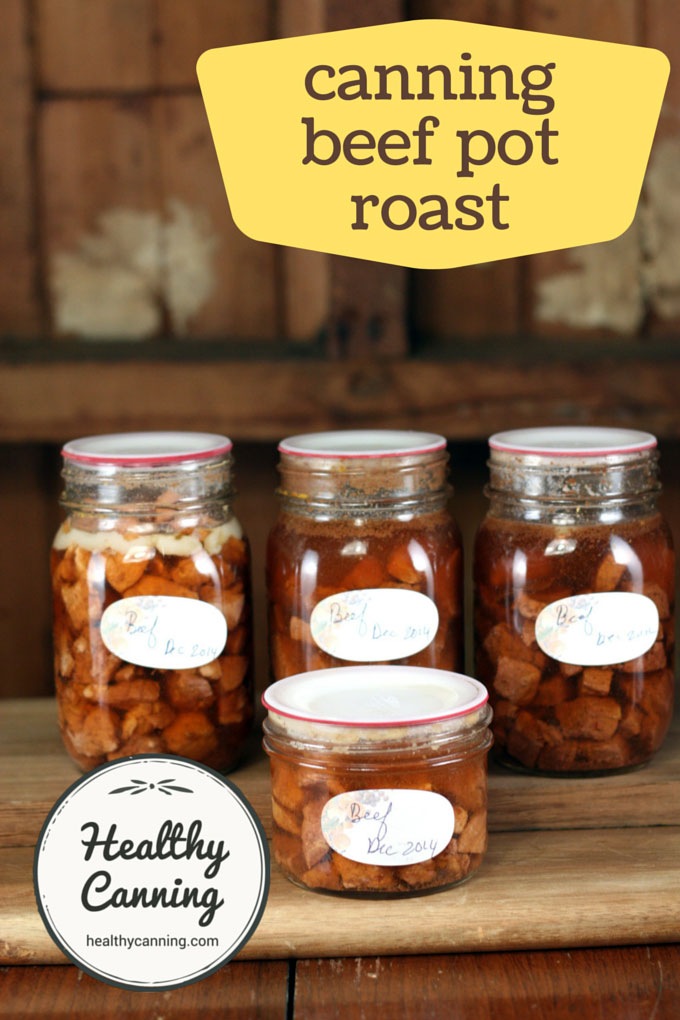
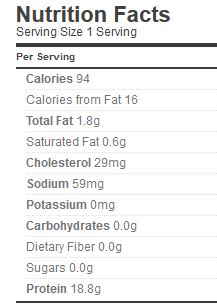
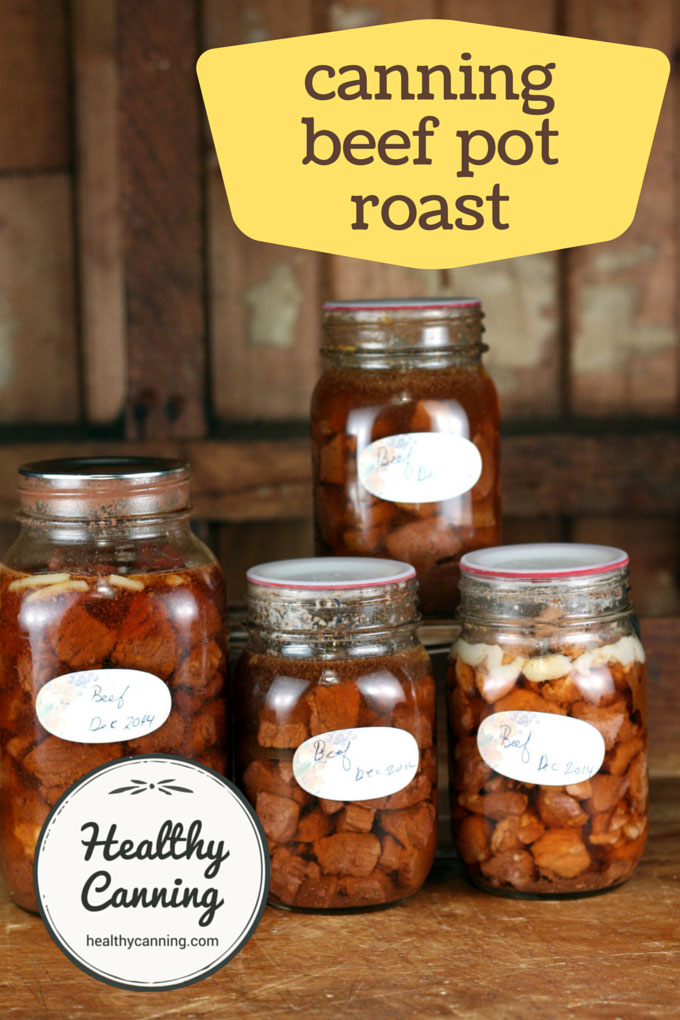
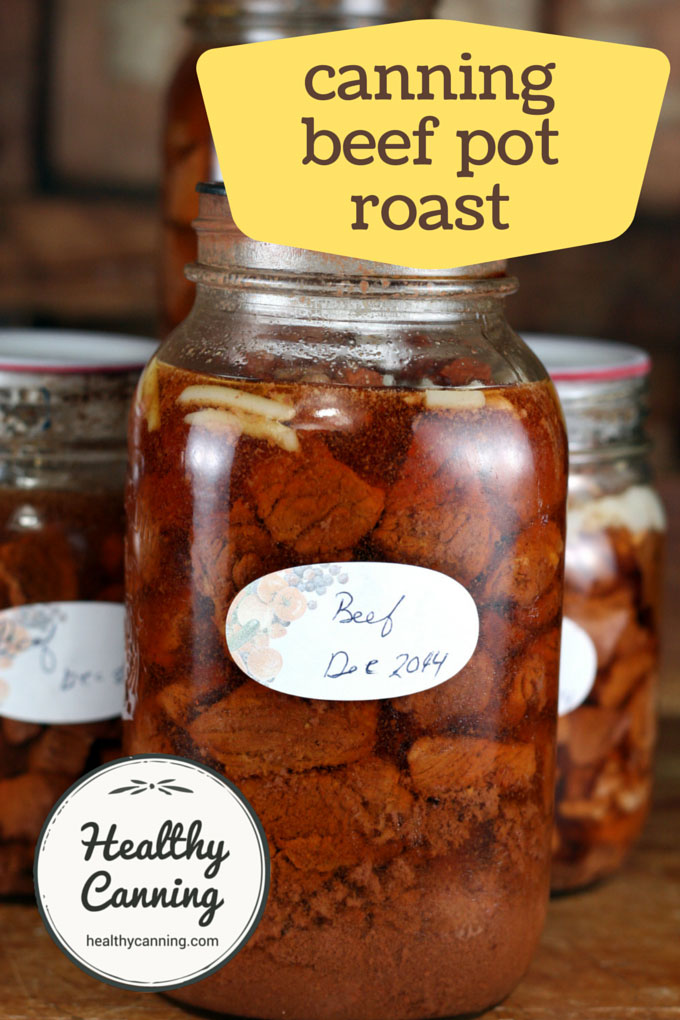
Barbara
How long can I keep canning meat
Healthy Canning
See: Storage life
John
So it is ok to use stock made from better than bullion when raw packing meat and to pack fairly tight?
Healthy Canning
It is fine to use stock made from ‘Better Than Bouillon’. Follow the packing directions of the particular recipe you are using.